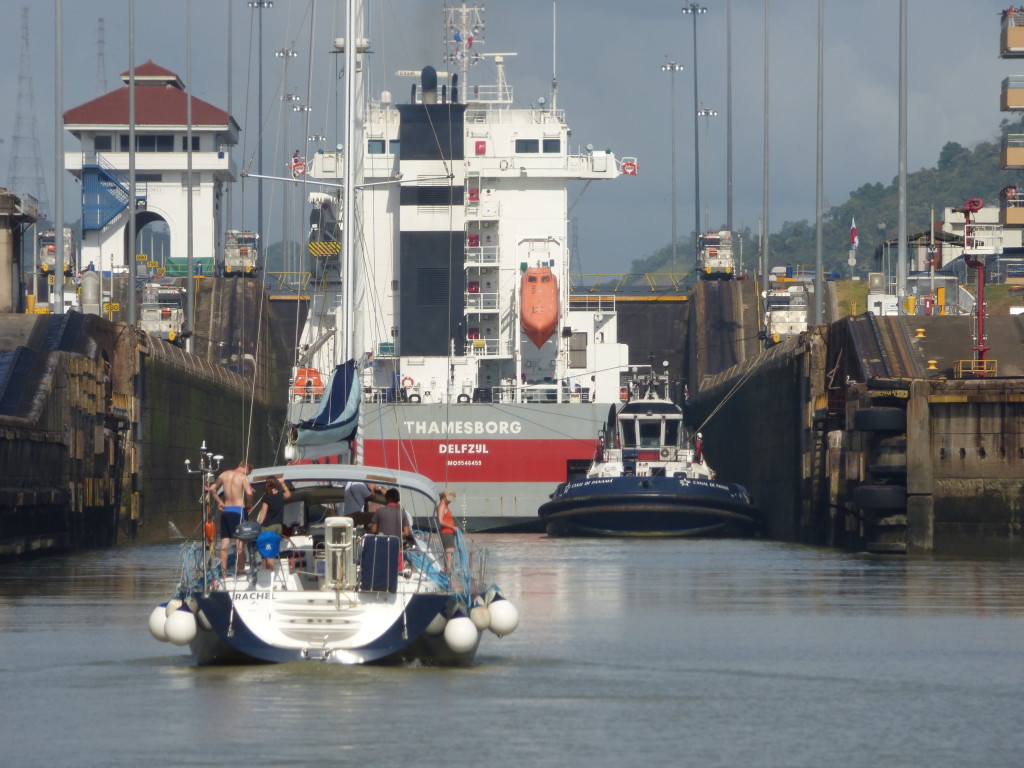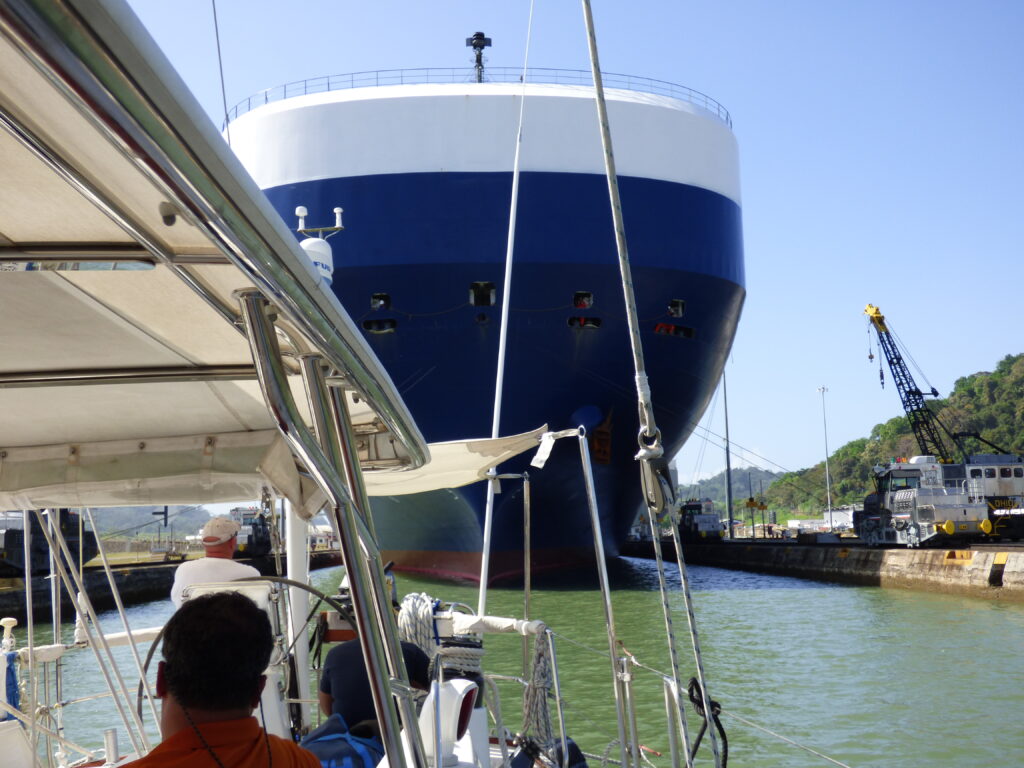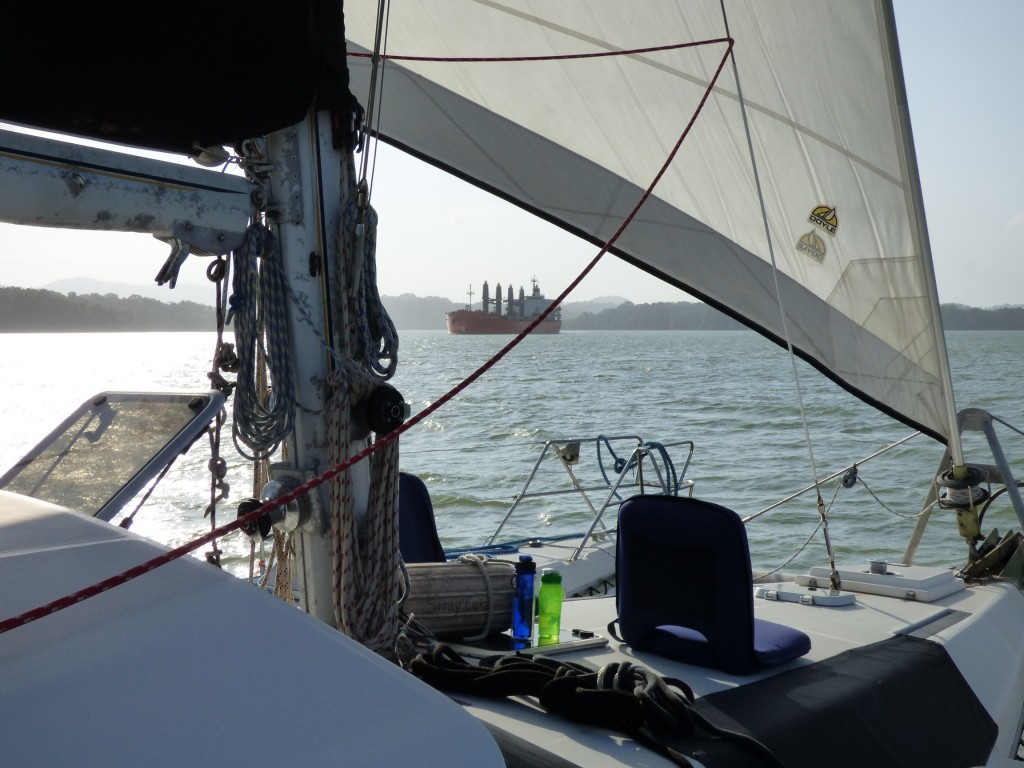Transit Procedure
The procedures for making a transit through the Panama Canal are as follows:
Southbound transits
- The ACP will give you a time to be ready at The Flats, commonly around 15:00
- The telephone number of the scheduler is (+507) 272-4202 and they should be contacted after 1800 hours on the night before the transit
- The Flats are now on the western side of the Bay (just outside the entrance to Shelter Bay Marina). The area is clearly marked by yellow buoys
- When you get there, call Cristobal Signal Station to announce your arrival and that you are awaiting on your Canal Advisor. One yacht called from Colon Yacht Club and was sent outside the breakwater, so it is probably better just to head to The Flats and call from there
- The Advisor joins sometime around the designated time (this can be hours later or might be brought forward)
- Up lock through Gatun Locks (3 steps) early evening and moor at one of two buoys on the lake. The transit time from the third (last) Gatun Locks chamber to the mooring buoys is approximately 20 minutes
- Remember to ask for a start time for the next morning, commonly 07:00. This time is not ‘set in stone’ and can be delayed or advanced by several hours. The Advisor typically travels from the Pacific side and can get caught up in traffic etc.
- A new Advisor arrives to cross the lake and lock down through Pedro Miguel (1 step) and Miraflores (2 steps)
- Hopefully completed by late afternoon – welcome to the Pacific!
Northbound transits
- The Advisor joins early morning at one of the Panama City-side yacht clubs
- Uplock up to Lake Gatun in the morning
- If your yacht is fast enough you can complete the lock down in the evening
- Otherwise you moor at a buoy or anchor at the northern end of Lake Gatun and complete the transit the next day, probably in the afternoon
General
- Most Advisors will discuss what is going to happen and ask who will handle which lines.
- Ensure each linehandler knows which rope they are responsible for, and that they can operate the cleats and/or winches. You do not want the Captain to be demonstrating how a winch works at the same time as navigating in the narrow lock chamber!
- The Advisor will not be sure of the method of transit until he contacts each of the three Lockmasters prior to the vessel entering the first lock chamber. What happens in Gatun Lock may not necessarily be repeated in Pedro Miguel/Miraflores and vice-versa.
- Once you arrive at the locks you will be busy for around two hours, so plan to provide meals before or after things get going.
- You should standby on VHF channel 12 while in Canal waters. The Advisor might ask you to change to channel 13 so you can listen to big ship pilots.
You will probably go through all the locks with a big ship in the same chamber. The order will be set by the Lockmaster but is generally as follows:
Locking Up
Usually the larger vessel will enter first for the uplock.

Things to be aware of:
- Possible violent turbulence as the water starts to fill each chamber. 26 million gallons will flood in from underneath, raising you up 28 feet either in 8 or 15 minutes depending on the Lockmaster
- Prop wash when the ship moves forward into the next chamber. The Canal Advisor might pressure you to let go quickly, but there is no rush as the big ship will take a while to move anyway
- The linehandlers need to keep taking up the slack in the lines as it appears, but in general they should keep the lines secure most of the time, especially when the lock first starts to fill
- Aim to keep your yacht or the raft in the centre of the lock and straight
- Each linehandler should look at the whole situation rather than focus solely on their one line. If your yacht is getting closer to the lock wall, perhaps it is time to stop pulling!
Locking Down
The larger vessel will enter behind you.

While there is no turbulence in the water from the lock filling, there are some more forces in play to make life interesting:
- A piston effect of the large vessel pushing water in front of it
- Currents of around 3-4 knots caused by fresh water rushing out over the top of salt water
- Commonly winds from the stern if heading south
- The linehandlers need to keep easing the lines as the water level drops, but in general they should keep the lines secure most of the time
- Aim to keep your yacht or the raft in the centre of the lock
- Each linehandler should look at the whole situation rather than focus solely on their one line
- Cleats that usually handle horizontal forces now experience vertical forces, so the linehandler needs to ensure that the lines are paying out evenly
- This is where your horn or whistle might be used, to let the shoremen know to throw the lines off when you are at the bottom of a lock and they can’t see you
On Lake Gatun and through Culebra Cut
The Canal Advisor will provide instructions but some considerations are:
- Although the Advisor will probably ask you to go as fast as you can, this is always with the proviso that you know your yacht can maintain that speed easily
- You will generally stay close to the marker buoys at the edge of the Canal
- The Advisor will tell you when you can cut across the Canal, often in an attempt to take ‘short-cuts’ to reduce the transit time
- The Advisor will regularly check-in to report your progress, and receive instructions as to the expected lockage time
Sailing is restricted but the Advisor might let you set a headsail

On to Lockage Types or back to Transit the Canal